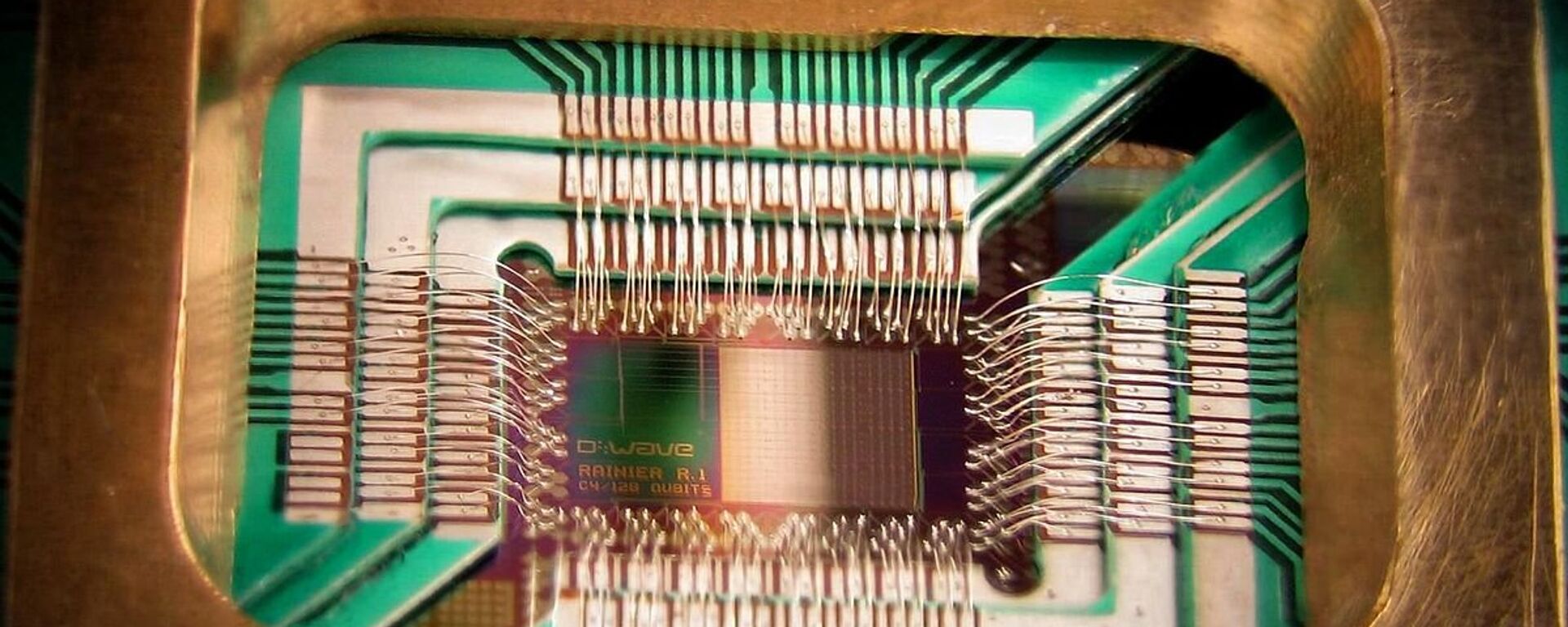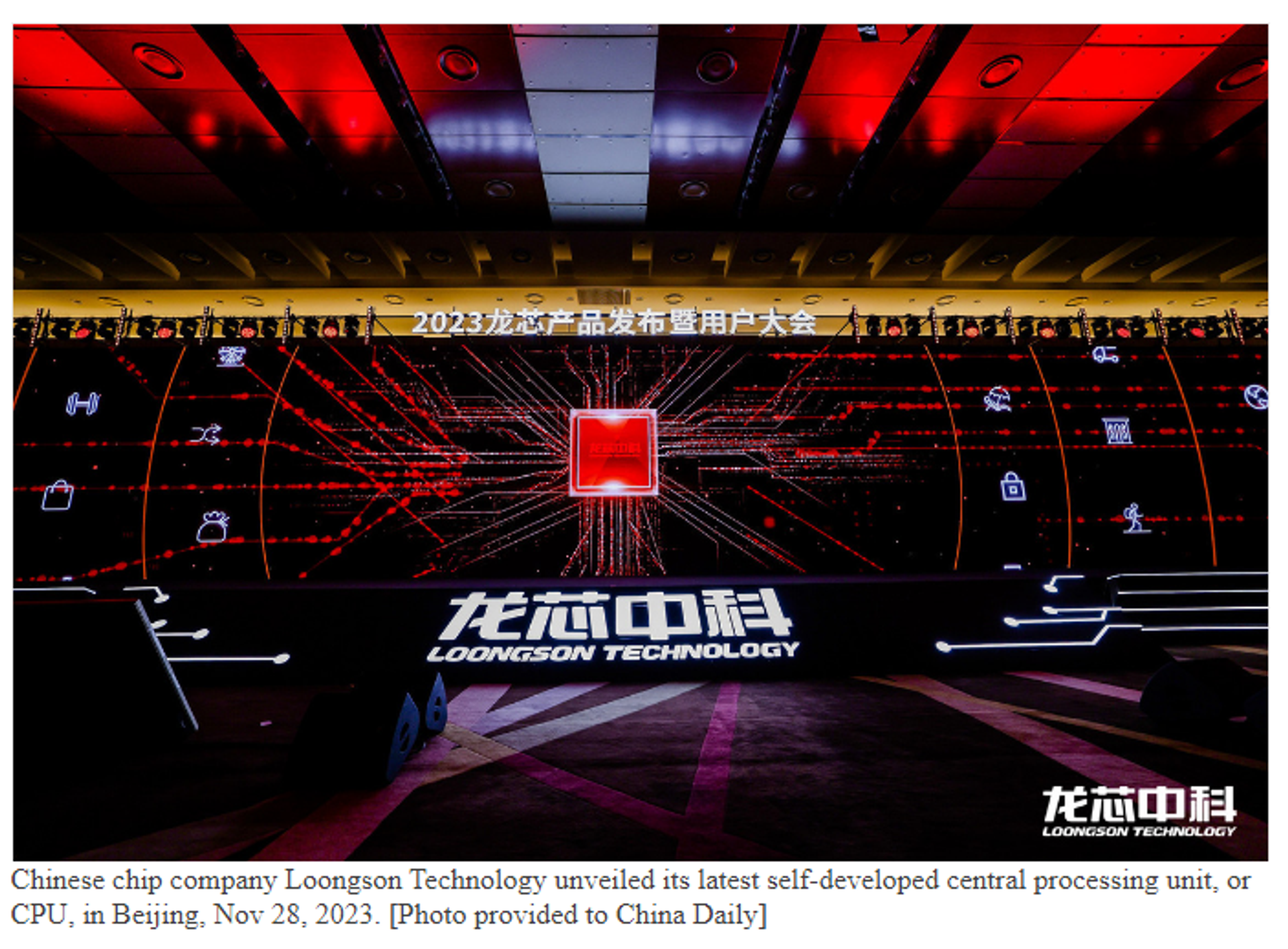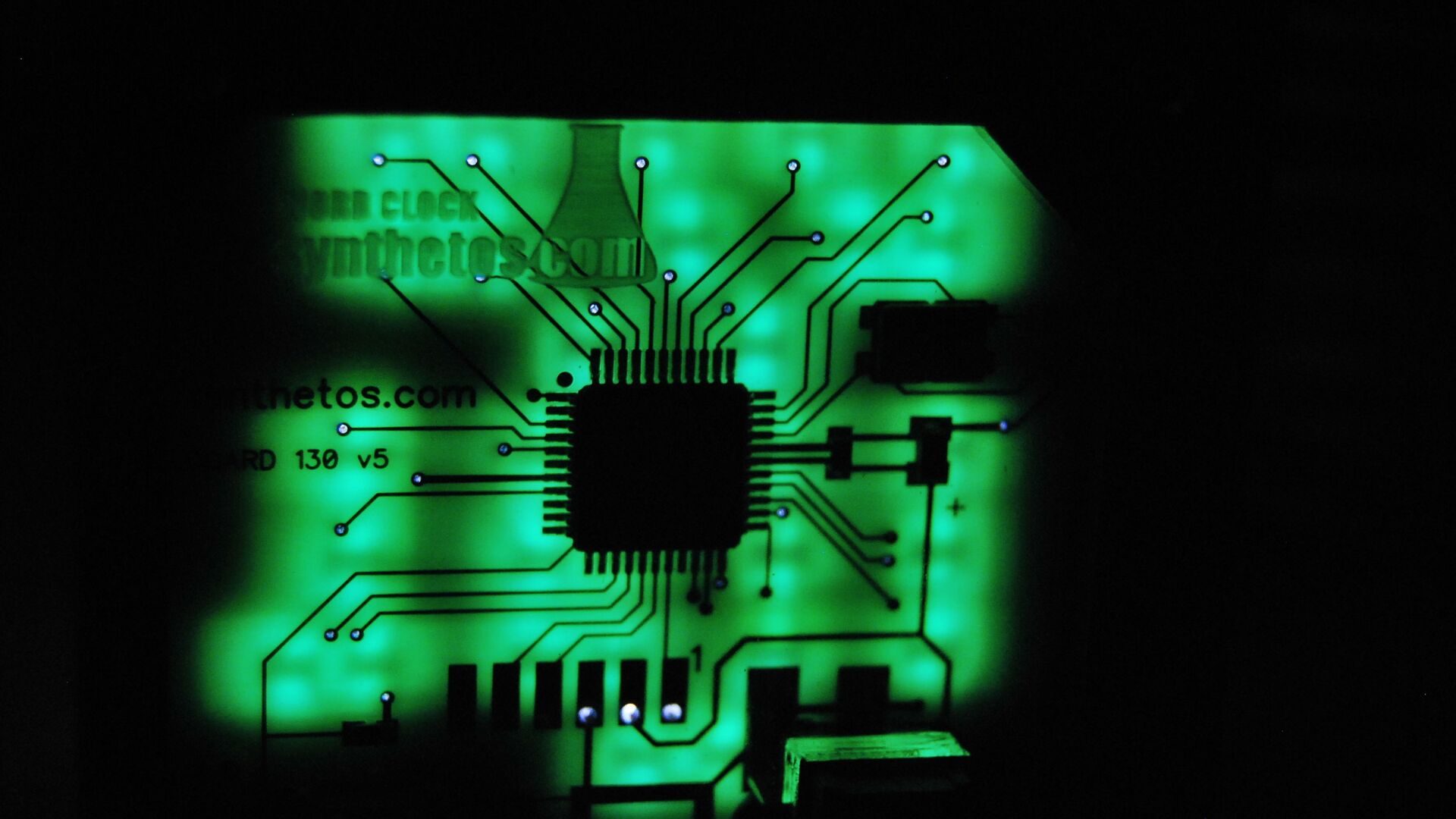https://sputnikglobe.com/20231128/chinas-new-loonsong-processor-blows-intel-out-of-water-secures-beijings-tech-sovereignty-1115258631.html
China’s New Loonsong Processor Blows Intel Out of Water, Secures Beijing’s Tech Sovereignty
China’s New Loonsong Processor Blows Intel Out of Water, Secures Beijing’s Tech Sovereignty
Sputnik International
Beijing has made a huge step towards securing its tech sovereignty, launching a new generation of homegrown computer CPU, Loongson 3A6000, China Central Television (CCTV) reported.
2023-11-28T18:45+0000
2023-11-28T18:45+0000
2023-11-28T18:45+0000
world
china
chip
joe biden
cctv
chinese academy of sciences (cas)
amd
intel
huawei
semiconductors
https://cdn1.img.sputnikglobe.com/img/107918/74/1079187450_0:105:3059:1826_1920x0_80_0_0_4f5c8bb3cbc58f5f2a0b4739a510319f.jpg
Beijing has made a huge stride towards securing its tech sovereignty, launching a new generation of homegrown computer CPUs, China Central Television (CCTV) reported.Undaunted by Washington’s relentless efforts to hinder the Asian giant's technological rise, China's flagship computer central processing unit designer, Loongson Technology Corp, unveiled the Loongson 3A6000 desktop-grade CPU on Tuesday.According to a Loongson announcement previously made on the Chinese site QQ.com, the Loongson 3A6000 uses proprietary instruction set architecture (ISA), Loongson Architecture (LoongArch), that has nothing to do with architectures designed outside China. The self-developed CPU can be used in multiple applications, across different platforms, for complex tasks, as per Loongson, cited by local media reports. Furthermore, the company also unveiled a printer main control chip, the Loongson 2P0500. The trailblazer chip is described as being the first based on an independent command system.According to Loongson, which was added to a US trade blacklist this year, the performance of the quad-core 3A6000 processor, which integrates four compute cores boasting 2.5 GHz CPU clock speed, is on par with Intel’s desktop models. Performance tests of Loongson 3A6000 carried out by the China Electronics Technology Standardization Institute reportedly suggested that the processor rivals Intel’s 10th generation quad-core processors launched in 2020.Founded by chief architect Hu Weiwu, Loongson Technology Corp originated as a research team under the Chinese Academy of Sciences. It has been on a mission to achieve independent CPU design, and slash China's reliance on American semiconductor producers like Intel and AMD.LoongArch, which the company has been working on for over 20 years, was originally based on the MIPS32 / MIPS64, as well as RISC-V ISAs. MIPS (Microprocessor without Interlocked Pipelined Stages), is developed by MIPS Computer Systems (currently MIPS Technologies), based in the United States. In late 2020, Loongson is said to have launched its home-grown 3A5000 CPU, based on process node of 14 nm. However, the US government prohibiedt Chinese semiconductor manufacturers from acquiring instruments and technologies required to produce chips with dimensions of 14 nm/16 nm or less, among other restrictions. As the US-China tech rivalry heated up, the Chinese government pledged more resources to support the development of crucial technologies.Semiconductor Trade WarAs competition with China became the primary strategic focus of US foreign policy, the tit-for-tat between Washington and Beijing over microchip manufacturing techniques escalated on October 7, 2022. That is when the Biden administration rolled out extensive restrictions on Beijing’s chip manufacturing industry. The measures required licenses for those companies that export chips to China using US tools or software, irrespective of where they are made in the world. The restrictions were preceded by President Joe Biden signing into law a bipartisan CHIPS and Science Act, which includes more than $52 billion for US companies producing semiconductors, as well as billions more in tax credits to encourage investment in the industry. Prior to that, under the Trump administration, the US and its Western allies targeted the People's Republic's telecom giants, such as Huawei, citing "security" concerns.Forced to import technology for its massive tech manufacturing industries, the Chinese government has embarked on a massive effort in recent years to master advanced chipmaking. Furthermore, in response to US restrictions, the East Asian country has moved to restrict exports of some of the key minerals used to manufacture those chips. New export controls on gallium and germanium came into force on August 1, restricting the sale abroad of eight products containing gallium and six containing germanium - two metals used to make semiconductors.However, despite industry warnings that Biden's semiconductor spat with China could backfire and threatened to sink the administration’s ambitious domestic microchip manufacturing goals, Washington was undeterred. Earlier this year, the White House warned the People's Republic of China about its intent to further tighten export rules for chipmaking tools and AI chips.China, the largest global semiconductors market, has repeatedly warned that by imposing restrictions on normal trade, the United States will end up harming itself as well as other market players."The US measures to restrict chip exports to China violate market rules and lead to fragmentation in the global semiconductors market, which not only harms lawful rights and interests of Chinese companies, but also significantly affects the interests of semiconductors manufacturers throughout the world, including in the US," China's Commerce Ministry spokesman He Yadong said in September.
https://sputnikglobe.com/20231122/us-china-chip-rivalry-finds-new-flashpoint-1115134803.html
https://sputnikglobe.com/20231006/us-chipmakers-warn-bidens-semiconductor-spat-with-china-could-backfire-1113973804.html
https://sputnikglobe.com/20231009/us-bound-to-lose-big-if-it-chips-away-at-chinas-tech-sector-1114040146.html
china
Sputnik International
feedback@sputniknews.com
+74956456601
MIA „Rosiya Segodnya“
2023
News
en_EN
Sputnik International
feedback@sputniknews.com
+74956456601
MIA „Rosiya Segodnya“
Sputnik International
feedback@sputniknews.com
+74956456601
MIA „Rosiya Segodnya“
china's new generation of homegrown computer cpu, loongson 3a6000, us-china tech race, semiconductor; investment fund; china; chips act, us-china trade war
china's new generation of homegrown computer cpu, loongson 3a6000, us-china tech race, semiconductor; investment fund; china; chips act, us-china trade war
China’s New Loonsong Processor Blows Intel Out of Water, Secures Beijing’s Tech Sovereignty
Amid the US-China trade rift, the Biden administration has been determined to clamp down on Beijing’s rapid advancements in high-tech sectors, restricting the Asian juggernaut’s access to advanced semiconductor technology, specifically ultra-modern chips, while ramping up domestic production of these components.
Beijing has made a huge stride towards securing its
tech sovereignty, launching a new generation of
homegrown computer CPUs,
China Central Television (CCTV) reported.
Undaunted by Washington’s relentless
efforts to hinder the Asian giant's technological rise, China's flagship computer central processing unit designer, Loongson Technology Corp, unveiled the
Loongson 3A6000 desktop-grade CPU on Tuesday.
According to a Loongson announcement previously made on the Chinese site QQ.com, the Loongson 3A6000 uses proprietary instruction set architecture (ISA), Loongson Architecture (LoongArch), that has nothing to do with architectures designed outside China. The self-developed CPU can be used in multiple applications, across different platforms, for complex tasks, as per Loongson, cited by local media reports. Furthermore, the company also unveiled a printer main control chip, the Loongson 2P0500. The trailblazer chip is described as being the first based on an independent command system.
According to Loongson, which was added to a
US trade blacklist this year, the performance of the quad-core 3A6000 processor, which integrates four compute cores boasting 2.5 GHz CPU clock speed, is on par with Intel’s desktop models. Performance tests of Loongson 3A6000 carried out by the
China Electronics Technology Standardization Institute reportedly suggested that the processor rivals Intel’s 10th generation quad-core processors launched in 2020.

22 November 2023, 15:09 GMT
Founded by chief architect Hu Weiwu, Loongson Technology Corp originated as a research team under the Chinese Academy of Sciences. It has been on a mission to achieve independent CPU design, and slash China's
reliance on American semiconductor producers like Intel and AMD.
LoongArch, which the company has been working on for over 20 years, was originally based on the MIPS32 / MIPS64, as well as RISC-V ISAs. MIPS (Microprocessor without Interlocked Pipelined Stages), is developed by MIPS Computer Systems (currently MIPS Technologies), based in the United States. In late 2020, Loongson is said to have launched its home-grown 3A5000 CPU, based on process node of 14 nm. However, the US government prohibiedt Chinese semiconductor manufacturers from acquiring instruments and technologies required to produce chips with dimensions of 14 nm/16 nm or less, among other restrictions. As the US-China tech rivalry heated up, the Chinese government pledged more resources to support the development of crucial technologies.

6 October 2023, 09:30 GMT
As
competition with China became the primary strategic focus of US foreign policy, the tit-for-tat between Washington and Beijing over microchip manufacturing techniques escalated on October 7, 2022. That is when the Biden administration rolled out extensive restrictions on Beijing’s chip manufacturing industry. The measures required licenses for those companies that export chips to China using US tools or software, irrespective of where they are made in the world. The restrictions were preceded by President Joe Biden signing into law a bipartisan CHIPS and Science Act, which includes more than
$52 billion for US companies producing semiconductors, as well as billions more in tax credits to encourage investment in the industry. Prior to that, under the Trump administration, the US and its Western allies
targeted the People's Republic's telecom giants, such as Huawei, citing "security" concerns.
Forced to import technology for its massive tech manufacturing industries, the Chinese government has embarked on a
massive effort in recent years to master advanced chipmaking. Furthermore, in response to US restrictions, the East Asian country has moved to restrict exports of some of the key minerals used to manufacture those chips. New export controls on
gallium and
germanium came into force on August 1, restricting the sale abroad of eight products containing gallium and six containing germanium - two metals
used to make semiconductors.
However, despite industry warnings that Biden's semiconductor spat with China could backfire and threatened to sink the administration’s ambitious domestic microchip manufacturing goals, Washington was undeterred. Earlier this year, the White House warned the People's Republic of China about its intent to
further tighten export rules for chipmaking tools and AI chips.

9 October 2023, 14:52 GMT
China, the largest global semiconductors market, has repeatedly warned that by imposing restrictions on normal trade, the United States will end up harming itself as well as other market players.
"The US measures to restrict chip exports to China violate market rules and lead to fragmentation in the global semiconductors market, which
not only harms lawful rights and interests of Chinese companies, but also significantly affects the interests of semiconductors manufacturers throughout the world, including in the US," China's Commerce Ministry spokesman He Yadong said in September.








